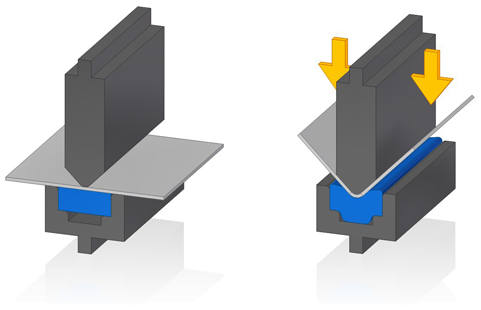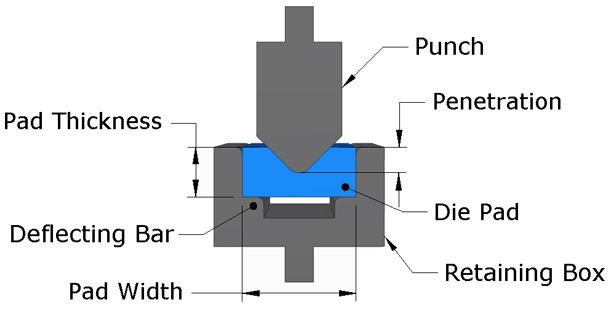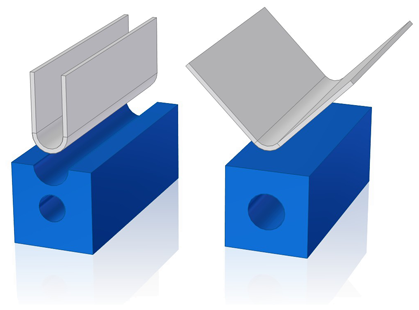Urethane and Polyurethane are interchangeable terms for an artificially created rubber. The mechanical properties of urethane allow for excellent resilience, toughness and load bearing capacity. These properties can be specifically controlled through different mixtures of the rubber’s ingredients. Urethane also has high resistance to mechanical fatigue, shear, and corrosion, impact and mold contamination.

Urethane Tooling incorporates a rubber pad held in place by a retaining block in place of a traditional die. Special punches are not required for this method of fabrication. The sheet metal is placed flat on top of the urethane pad before the punch tip s forced down into the pad. As this happens the pad deforms around the punch providing pressure against the work piece, forming it against the punch. Below is an example of a basic setup with a large radius die.
Urethane Tooling is advantageous when the goal is to form large radii, minimize die marking or form complicated profiles in a single stroke. Below are the pros and cons of utilizing this tooling.
Pros:
- The pads will not mark the work piece during the bending process. The urethane is always going to be softer than the metal being formed against it which means it won’t leave scratches or marks. This eliminates the need for secondary cleaning operations. Using a urethane pad for the initial acute bend can eliminate the marking commonly associated with hemming.
- The urethane pad will flow like a fluid exerting pressure upwards almost evenly along the punch tip. This makes it ideal for bending special curves machined into the punch.
- When deep Box Bending with an, unbalanced, 30°-60° punch the urethane pad it reduces the side thrust associated with this setup. This can reduce wear on the tooling and punch holders.
- A single die setup can be used with a variety of punch tips, radii and material thicknesses. This reduces the need for multiple setups when switching operations.
- The pressure exerted back on the punch eliminates the multi-breakage phenomenon which hinders most large radius bending operations. Consistency in the roundness of the bend is maximized with Urethane Tooling.
- The support that the pad provides the work piece during the bend helps to reduce Spring Back by approximately 60%.
- When embossing a work piece with a logo or other complicated form a urethane pad can be a very cost effective alternative to a custom machined bottom die.
Cons:
- The tonnage requirement for the press brake is going to be much greater than compared to a typical v die. The Brake Press has to work to overcome not only the sheet metal, but the urethane pad as well. Because of this your gauge selection is typically limited to lighter materials.
- The lifespan of a urethane pad is going to be greatly reduced compared to that of properly treated steel tooling. While the pads are not cost prohibitive for most operations, they do need to be replaced often.
- The minimum flange lengths dictated by the Air Bend Force Chart doesn’t necessarily apply to urethane tooling because there is theoretically support for even the smallest of flanges. However in practice small flanges will slide away from the punch tip and the chart does provide a typically safe starting point for flange length.
Terminology
Urethane tooling has its own set of terminology which is important to understand when investigating this type of die for your shop. For clarity the below diagram does not show the sheet metal work piece.

- Punch – As mentioned earlier any standard punch can be used with urethane dies.
- Die Pad – The actual block of urethane which provides resistance against the punch and work piece. Here the die pad is shown as a solid block though it is common to see pads with a hollow core.
- Retaining Box – A support box which sits in the die holder. The pad is seated inside the box and it provides horizontal support for the pad during the bending process.
- Deflecting Bar – These bars are added to the base of the retaining box in order to allow the pad to flex more during the process. This reduces the required tonnage for bending and is often used with a solid die pad.
- Pad Thickness – The height or thickness of the urethane pad.
- Pad Width – The width of the urethane pad.
- Pad Volume (PW) – The volume of the die pad, also known as the Working Volume, length * width * thickness.
- Punch Tip Penetration – The vertical distance that the punch tip needs to move past the original top of the urethane pad in order to form the desired part.
- Punch Volume (PV) – The volume of the punch tip, when bending with a radius punch. Formula will use Material Thickness (MT), the Punch Radius (RP) and the Length of the Punch (L).
- Die Pad Color– Urethane tooling comes in 4 colors denoting their durometer, or hardness rating.
- Red
- Type: 0
- Durometer: 80A
- Soft, 35% Deflection
- Uses: General Use Tooling, V Bending, Unbalanced Bending and Form Bending.
- Blue
- Type: 1
- Durometer: 90A
- Medium, 25% Deflection
- Uses: General Use Tooling, V Bending, Unbalanced Bending and Form Bending.
- Yellow
- Type:2
- Durometer: 95A
- Hard, 15% Deflection.
- Uses: Used for V bends and U Bends.
- White
- Type: 3
- Durometer: 75A
- Very Hard, 5% Deflection
- Uses: Special Applications.
- Red
Die Selection
In order to ensure that there is no failure of the die and that the pad is going to have enough room for deflection there are a few rules of die selection that you should follow. V shaped pads are available which fit into standard v opening tooling. V shaped pads can accommodate very small flanges, though a wrap piece may be necessary to prevent the tip from digging into the urethane. Before selecting a v shaped pad, you must first consider the same volume requirements as a rectangular pad.
Pad Width (PW) – The minimum width of your urethane pad is twice the Punch Tip Penetration (PP).
Pad Thickness (PT) – The minimum pad width is going to be 3 times the Punch Tip Penetration (PP).
Pad Volume (WV) – The minimum pad volume is going to be 10 times the Punch Volume (PV)
Tonnage
Compared to regular v opening bending Urethane Tooling will require significantly more tonnage to achieve the same type of bend. This tonnage will be at least 3 times that of Air Bending. Deflection bars and customized pads can be used to reduce the tonnage. Estimating the tonnage can be rather difficult so prototype bending is almost always going to be required. To begin your test bends the following formula can be used to get you close to the correct tonnage. The formula will incorporate the Material Thickness (MT) and the the Inside Radius (IR) of the bend to determine the number of tons per inch required.
Pad Types
The term poly-die is used to describe a urethane pad with a an open area inside its profile. The usually circular opening is used to reduce the required tonnage when forming a bend. Poly-dies are typically divided into two categories; flat poly-dies (PODs) and poly-u-dies (PUDs). PODs are poly dies with flat forming surfaces. PODs are used to form up to 90° bends with varying radii. PUDs are poly-dies with a U shaped relief on the forming surface. By forming the sheet metal into this feature 180° bends can be formed in a single stroke, over bending up to 15° to accommodate spring back. Below the PUD is shown on the left and the POD on the right along with a sample profile.
